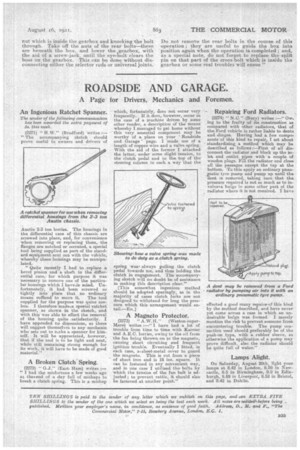ROADSIDE AND GARAGE.
Page 31

If you've noticed an error in this article please click here to report it so we can fix it.
A Page for Drivers, Mechanics and Foremen.
An Ingenious Ratchet Spanner.
The sender of the following communication has been awarded the extra payment of 5s. this week, (2271) " /LW." (Bradford) writes :— " The accompanying sketch should prove useful to owners and drivers of Austin 2-3 ton lorries. The housings in the differential case of this chassis are screwed into place, and, for convenience wheu removing or replacing them, the flanges are notched or serrated, a special tool being supplied as part of the standard equipment sent out with the vehicle, whereby these housings may be manipalated.
" Quite recently I had to replace a bevel pinion and a shaft in the differential case, for which purpose it was necessary to remove one of the particular housings which I haved.e. mind. Unfortunately, it had be,en .screwed so tightly into place that, no ordinary means sufficedto move it. The tool supplied for the purpose was quite useless. I thereforsemadeta special ratchet spanner, as shown in the sketch, and with this was able to effect the removal of the housing quite .satisfactorily. I have appended no dimensions, as these will suggest themselves to any mechanic who sets out to make a spanner for himself. It will be appreciated, however, that if the tool is to be light and neat, while still remaining strong enough for its work, it will have to be made of good material."
A Broken Clutch Spring.
(2272) ' G.J." (East. Ham) writes :" I had the misfortune a few weeks age at theaencl of a day full of mishaps to break a clutch spring. This is a mishap which, fortunately, does not occur very frequently. If it. does, however, occur in the ease of a machine driven by some other reader, a description of the means whereby I managed to get home without this very essential component may be worthy of a _place on your Roadside and Garage ' page. I made use of a length of copper wire and a valve spring. With the aid of the former I attached the latter, under some slight tension, to the clutch pedal and to the. top of the steering column in such a way that the spring was, always pulling the clutch pedal towards me, and thus holding the clutch in engagement. The accompanying sketch will no doubt be of assistance in snaking this description clear."
[This somewhat, ingenious method shonld be adopted sparingly, as in the majority of eases clutch forks are not designed to withstand for long the pressure which thisarrangement would entail.—Eo. j
A Magneto Protector.
(2273) " A . W. IL ' (Weston-super
Mare) writes :—" I have had a lot of trouble from timeto time with Karrier and A.E.C. lorries, owing to the oil from the fan being thrown on to the magneto, causing short circuiting and frequent ignition trouble. Eventually I fitted, in each case, a-,sheet-metal cover to guard the magneto. This is cut front a piece of sheet iron and is 18 ins. square. It can be fastened in any convenient way, and in one caw I utilized the bolts by which the tension of the fan belt is adjusted; to prevent rattle, it should also be fastened at another point:" Repairing Ford Radiators.
(2274) " N.C." (Bury) writes :—"
ing to the frailty -of its construdion as compared with other radiators, that of the -Ford vehicle is rather liable to dents and.dinges. Having had a few components of this kind to repair, IL set about standardizing, a method which may be described as follows :—First of all disconnect the radiator and block up the inlet and outlet pipes with a couple of• wooden plugs. rill the radiator and close all the passages except the tap at the bottom. 'Ma this apply an ordinary pneupiatic tyre pump and pump up until the dent Is removed, taking bare thatthe pressure required is not so much as to involvesa bulge in some other part of the radiator where it is not required. I have effected a good many repairs-of this kind by the method described, and have never yet come across a case in which an undesirable bulge was formed. I merely mention the risk to prevent someone from encountering trouble. The pump connection used should preferably be of the push-on type, with a -rubber sleeve, as otherwise the application of a pump may prove difficult, also the radiator should be quite fall of water."
Lamps Alight.
On Saturday, August 20th, light your lamps at 8.42 in London, 8.59 in Newcastle, 8.5 in Birmingham, 9.9 in Edinburgh, 8.69 in Liverpool, 8.52 in Bristol, and 9.42 in Dublin.
































